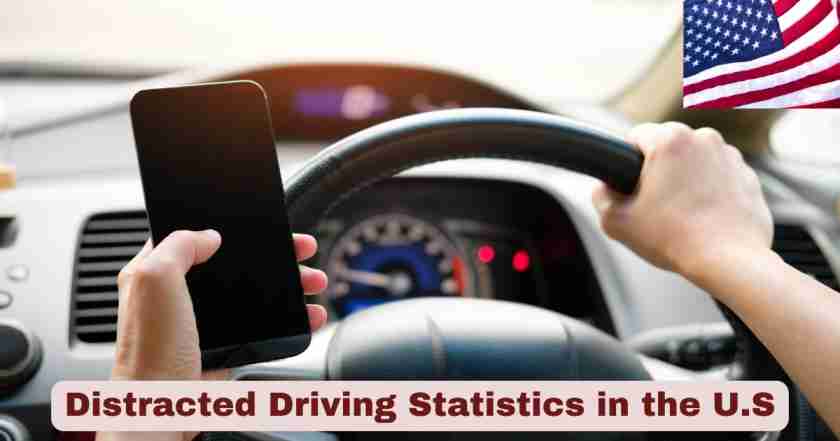Distracted Driving in the U.S. in 2025
The United States continues to grapple with the devastating consequences of distracted driving, a preventable epidemic that claims thousands of lives annually. As we navigate through 2025, the latest data reveals alarming trends that demand immediate attention from policymakers, law enforcement, and drivers themselves. Distracted driving, defined as any activity that diverts attention from the primary task of driving, has evolved beyond traditional concerns to encompass a wide range of modern behaviors that endanger everyone on American roads.
Recent statistics paint a sobering picture of the current state of road safety in America. With the proliferation of smartphones, in-vehicle technology, and the constant connectivity of modern life, drivers face more distractions than ever before. The National Highway Traffic Safety Administration (NHTSA) reports that 3,275 people were killed in distraction-affected crashes in 2023, representing a critical public health issue that affects families and communities across the nation. Understanding these statistics is essential for developing effective prevention strategies and promoting safer driving behaviors that can save lives.
Facts About Distracted Driving in the U.S. in 2025
| Fact Category | Key Statistics | Source |
|---|---|---|
| Daily Fatalities | 9 people die every day in distracted driving crashes | CDC |
| Economic Impact | $98 billion in economic costs from distracted driving crashes (2019 data) | NHTSA |
| Total Societal Cost | $395 billion including quality-of-life valuations (2019 data) | NHTSA |
| Crash Percentage | 8% of all fatal crashes involve distracted drivers | NHTSA 2023 |
| Phone Usage | 60.2% of drivers report talking on phone while driving | Industry Survey |
| Texting While Driving | 47% of drivers admit to texting while driving | Industry Survey |
| Teen Risk Factor | 7% of teen drivers (15-20) in fatal crashes were distracted | NHTSA 2023 |
| Injury Crashes | 13% of all injury crashes involve distracted drivers | NHTSA 2023 |
| Pedestrian Deaths | 611 nonoccupants killed in distraction-affected crashes in 2023 | NHTSA 2023 |
| High School Students | 39% of high school students admit to texting while driving | National Survey |
The data presented in this comprehensive table reveals the multifaceted nature of distracted driving in America. The fact that nine people lose their lives daily due to distracted driving crashes underscores the urgent need for continued awareness and prevention efforts. The economic burden of $98 billion annually represents not just financial costs but also the profound human suffering behind these statistics. When quality-of-life factors are considered, the total societal impact reaches a staggering $395 billion, demonstrating that distracted driving affects society far beyond the immediate victims and their families.
The behavioral statistics are equally concerning, with 60.2% of drivers admitting to talking on their phones while driving and 47% acknowledging texting while driving. These self-reported behaviors likely represent conservative estimates, as many drivers may be reluctant to admit to dangerous behaviors. The high percentage of teen drivers (7%) involved in fatal distraction-affected crashes highlights the particular vulnerability of young drivers, who may lack the experience and judgment necessary to safely manage multiple tasks while driving.
Distracted Driving Fatalities in the U.S. in 2025
| Year | Total Fatalities | Distracted Driving Fatalities | Percentage of Total | Cellphone-Related Deaths |
|---|---|---|---|---|
| 2019 | 36,355 | 3,119 | 9% | 430 |
| 2020 | 39,007 | 3,154 | 8% | 397 |
| 2021 | 43,230 | 3,521 | 8% | 423 |
| 2022 | 42,721 | 3,315 | 8% | 406 |
| 2023 | 40,901 | 3,275 | 8% | 397 |
The latest fatality data from NHTSA reveals both encouraging and concerning trends in distracted driving deaths across the United States. In 2023, 3,275 people lost their lives in crashes involving distracted drivers, representing 8% of all traffic fatalities for that year. While this represents a slight decrease from the 3,315 deaths recorded in 2022, the numbers remain alarmingly high and demonstrate that distracted driving continues to be a significant threat to public safety.
The consistency of distracted driving fatalities comprising approximately 8% of all traffic deaths over the past several years indicates that despite increased awareness campaigns and technological solutions, the problem persists at concerning levels. Cellphone-related deaths, while representing a smaller subset of distracted driving fatalities, accounted for 397 deaths in 2023. This figure underscores the particular danger posed by mobile device usage while driving, especially considering that cellphone use represents just one type of distraction among many that drivers face daily.
Age-Related Distracted Driving Patterns in the U.S. in 2025
| Age Group | Total Drivers in Fatal Crashes | Distracted Drivers | Percentage Distracted | Cellphone Use |
|---|---|---|---|---|
| 15-20 | 5,133 | 348 | 7% | 55 |
| 21-24 | 5,101 | 298 | 6% | 48 |
| 25-34 | 11,916 | 710 | 6% | 88 |
| 35-44 | 9,876 | 545 | 6% | 73 |
| 45-54 | 8,116 | 366 | 5% | 43 |
| 55-64 | 7,560 | 358 | 5% | 37 |
| 65-74 | 4,954 | 250 | 5% | 21 |
| 75+ | 3,458 | 188 | 5% | 3 |
The age-based analysis of distracted driving reveals critical insights into which demographics are most at risk for engaging in dangerous behaviors while driving. Young drivers aged 15-20 show the highest rate of distraction involvement, with 7% of this age group being distracted in fatal crashes. This represents a significantly higher percentage compared to older age groups, where distraction rates remain relatively stable at 5-6% across middle-aged and older drivers.
The data clearly demonstrates that young adult drivers (15-20 and 21-24) represent a disproportionate risk group for distracted driving behaviors. The 25-34 age group, while showing a 6% distraction rate, accounts for the largest absolute number of distracted drivers (710 drivers) involved in fatal crashes, reflecting both their higher crash involvement and the size of this demographic on the roads. The gradual decline in distraction rates among older age groups suggests that driving experience and maturity may contribute to better attention management while driving, though the consistent presence of distracted driving across all age groups indicates that this is a universal problem requiring comprehensive solutions.
Injury and Economic Impact of Distracted Driving in the U.S. in 2025
| Impact Category | 2023 Data | Percentage/Details |
|---|---|---|
| People Injured | 324,819 | 13% of all traffic injuries |
| Injury Crashes | 222,396 | 13% of all injury crashes |
| Property Damage Crashes | 556,541 | 13% of all PDO crashes |
| Total Crashes | 781,958 | 13% of all police-reported crashes |
| Economic Cost | $98 billion | Annual economic impact |
| Societal Cost | $395 billion | Including quality-of-life valuations |
| Cellphone-Related Injuries | 30,970 | 10% of distracted driving injuries |
| Non-Occupant Deaths | 611 | Pedestrians, cyclists, others |
The comprehensive economic and injury data reveals the staggering scope of distracted driving’s impact on American society. In 2023, an estimated 324,819 people were injured in distraction-affected traffic crashes, representing 13% of all people injured in motor vehicle accidents. This consistency across different crash severity levels, with 13% of injury crashes and 13% of property-damage-only crashes involving distracted drivers, demonstrates that distraction affects all types of traffic incidents, not just the most severe crashes.
The economic burden of distracted driving extends far beyond immediate medical costs and property damage. The $98 billion in annual economic costs includes lost productivity, workplace costs, legal expenses, medical care, emergency services, insurance administration, traffic congestion impacts, and property damage. When quality-of-life valuations are incorporated, the total societal cost reaches $395 billion annually, reflecting the immeasurable human suffering and lost potential that results from these preventable crashes. The 30,970 people injured in cellphone-related crashes specifically highlight the particular danger posed by mobile device usage while driving, emphasizing the need for targeted interventions addressing this specific form of distraction.
Types of Distracted Driving Behaviors in the U.S. in 2025
| Distraction Type | Description | Risk Level | Prevalence |
|---|---|---|---|
| Visual Distraction | Taking eyes off the road | High | Most common |
| Manual Distraction | Taking hands off wheel | High | Second most common |
| Cognitive Distraction | Taking mind off driving | High | Often unrecognized |
| Cellphone Talking | Conversations while driving | Medium-High | 60.2% of drivers |
| Texting/Messaging | Reading/sending text messages | Extreme | 47% of drivers |
| Eating/Drinking | Consuming food or beverages | Medium | Very common |
| Adjusting Controls | Radio, climate, navigation | Medium | Universal behavior |
| Passenger Interaction | Talking to vehicle occupants | Medium | Family trips |
The classification of distracted driving behaviors into visual, manual, and cognitive categories provides a framework for understanding the different ways attention can be diverted from driving. Visual distractions, which involve taking one’s eyes off the road, represent the most immediately dangerous form of distraction, as drivers cannot respond to hazards they cannot see. Manual distractions require drivers to remove their hands from the steering wheel, reducing their ability to maintain vehicle control and respond quickly to changing road conditions.
Cognitive distractions, while often overlooked, can be equally dangerous as they involve taking one’s mind off the driving task. The prevalence of cellphone talking (60.2% of drivers) and texting while driving (47% of drivers) demonstrates how mobile technology has become integrated into driving behavior despite its significant risks. Texting while driving is particularly dangerous because it combines all three types of distraction simultaneously, requiring drivers to look at their phone, use their hands to type, and think about their message rather than focusing on driving. The universal nature of other behaviors like eating, drinking, and adjusting vehicle controls highlights that distracted driving encompasses a broad range of activities that drivers often consider routine but can have serious safety consequences.
State Laws and Prevention Efforts in the U.S. in 2025
| Prevention Strategy | Implementation Status | Effectiveness | Coverage |
|---|---|---|---|
| Handheld Phone Bans | 28 states + DC | Moderate | Growing |
| Texting Bans | 48 states + DC | High | Near universal |
| All-Phone Bans (New Drivers) | 38 states + DC | High | Most states |
| School Bus Driver Bans | 24 states + DC | High | Expanding |
| High-Visibility Enforcement | Selective implementation | High | Limited |
| Public Awareness Campaigns | National and state level | Moderate | Widespread |
| Technology Solutions | Apps and vehicle features | Emerging | Voluntary |
| Driver Education Programs | Varies by state | Moderate | Inconsistent |
The legislative landscape surrounding distracted driving shows significant progress in recent years, with 48 states plus the District of Columbia implementing texting bans, representing near-universal coverage for this particularly dangerous behavior. Handheld phone bans have been adopted by 28 states plus DC, though coverage remains incomplete across the nation. The implementation of all-phone bans for new drivers in 38 states plus DC recognizes the particular vulnerability of inexperienced drivers to distraction-related crashes.
High-visibility enforcement campaigns have shown the most promising results in reducing distracted driving behaviors, though these intensive efforts are resource-intensive and often limited in scope and duration. The NHTSA’s annual “U Drive. U Text. U Pay.” campaign represents a coordinated national effort to raise awareness and promote enforcement of distracted driving laws. Technology solutions, including smartphone apps that block calls and texts while driving and vehicle-based systems that limit functionality while in motion, represent emerging approaches to preventing distracted driving, though their effectiveness depends on voluntary adoption and proper use by drivers.
Recommendations for Preventing Distracted Driving in the U.S. in 2025
| Recommendation Level | Action Items | Target Audience | Expected Impact |
|---|---|---|---|
| Individual Drivers | Put phones away, pull over to text | All drivers | High |
| Parents | Set rules, model behavior | Teen drivers | High |
| Employers | Implement no-phone policies | Commercial drivers | High |
| Schools | Driver education programs | Student drivers | Medium |
| Law Enforcement | Increase visibility, consistent enforcement | All drivers | High |
| Technology Companies | Develop better safety features | All drivers | Medium |
| Policymakers | Strengthen laws, increase penalties | All drivers | Medium |
| Community Organizations | Awareness campaigns, peer education | Local communities | Medium |
The multi-layered approach to preventing distracted driving requires coordinated efforts across all levels of society. Individual drivers bear the primary responsibility for their behavior and must commit to keeping their phones out of reach while driving and pulling over safely when they need to make calls or send messages. Parents play a crucial role in shaping young drivers’ behaviors by establishing clear rules about phone use in vehicles and consistently modeling safe driving practices themselves.
Employers have significant influence over commercial drivers and employees who drive for work purposes, and implementing comprehensive no-phone policies can substantially reduce distracted driving incidents. Law enforcement agencies must maintain consistent, high-visibility enforcement of distracted driving laws to create a deterrent effect and change driver behavior. The combination of stronger legislation, enhanced enforcement, improved technology, and comprehensive education offers the best hope for reducing the devastating toll of distracted driving on American roads. Success in addressing this issue will require sustained commitment from all stakeholders and continued adaptation to new technologies and changing driving behaviors.
Disclaimer: The data research report we present here is based on information found from various sources. We are not liable for any financial loss, errors, or damages of any kind that may result from the use of the information herein. We acknowledge that though we try to report accurately, we cannot verify the absolute facts of everything that has been represented.







